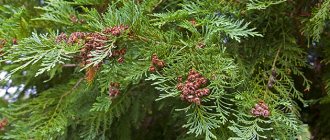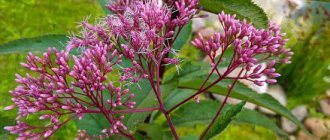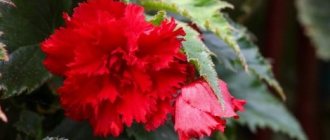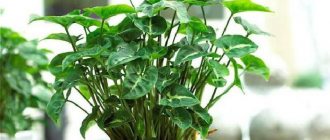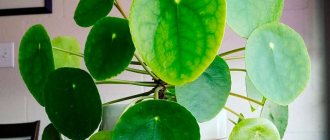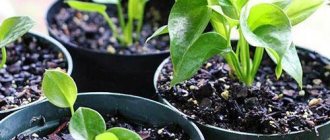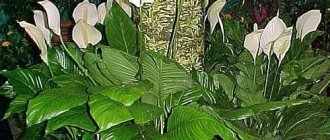Types and varieties of indoor syngonium: photos, names, descriptions of varietal varieties of flowers
In total, there are 35 species in the genus Syngonium. A complete list of syngonium species with Latin names is contained in the database of the Royal Botanic Gardens, Kew. Among them are Syngonium angustatum, Syngonium steyermarkii, Syngonium vellozianum, Syngonium triphyllum, Syngonium chiapense and others.
The most famous is the auricular syngonium ( Syngonium auritum ) - a vine with long clinging shoots, easily forms roots in the internodes, the leaves are glossy and green, young ones are almost arrow-shaped, old ones have a thrice-dissected plate and two ear-shaped small segments at the base. The length of its petioles is three to four tens of centimeters.
Wendland syngonium (Syngonium wendlandii) is considered rarer . A liana with leaves that are velvety to the touch (up to 19 cm in length and up to 8 cm in width), arrow-shaped, with a “tip” divided into three. It grows slowly, the size of the petioles reaches 20-30 cm. The plant's homeland is Costa Rica.
Legleaf (Syngonium podophyllum ) is the third of the syngonium species grown as indoor flowers, the most popular among gardeners. Native to Central America, where its fruits are eaten by the local population, in nature it is an intensively branching vine with flexible and thin shoots covered with large petiolate leaves. The petioles are long, up to 60 cm, the stems are covered with a waxy coating.
There are also variegated varieties of Syngonium podophyllum on sale, which are difficult to identify because they are hybrids. Varietal syngoniums are valued for their exotic coloring. They have somewhat poetic names associated with their external differences. Some varieties of syngonium are described below.
Pixie - plants of this variety are compact, with small green leaves and white spots located along the veins.
Bob Allusion - leaves are round, leathery, olive green in color when young, with noticeable pink veining.
Neon Robusta is a lush bush with bright pink leaves.
Regina Red - Known for its arrow-shaped, bicolor leaves, pink on top and green on the underside. The brightness of their color is directly related to the intensity of lighting.
Silver Moon - leaves are round, emerald in color, in the center there is a milky white spot with jagged edges.
Gold Allusion is a light golden vine with medium-sized leaves with bright pink veins.
Cream Allusion - bushes at the base, leaf color varies from silver to cream, veins are colored pink of varying intensities.
Mango Allusion – soft green foliage with pink centers.
White Butterfly is a variety with elongated, spear-shaped leaves. Their color can be green, milky, yellow, creamy pink. The leaf is covered with a web of light veins.
Panda - many yellow spots on a dark green leaf blade.
Arrow - distinguished by a variegated pattern around the veins, large shoots.
Salad - light green leaves with darker edges.
Silver Pearl - leaves are milky white above, light green below.
Angel baby, Fairy wings are dwarf representatives.
The photo shows decorative varieties of syngonium:
Syngonium has several distribution areas, but each species has an exotic homeland: South America (grows in French Guiana, Guyana, Suriname, Venezuela, Bolivia, Colombia, Ecuador, Peru, Brazil) or Central America (16 species are found in Costa Rica and Panama plants); In addition, some species grow in Mexico and the West Indies (Cuba, Jamaica, Haiti).
The names and differences between the types of syngonium are shown in the photo:
Syngonium auritum
The second most common species in indoor collections after the described variety was syngonium auricata. This is a large climbing vine, with high growth rates, original shaped leaves and rather thick, strong stems. In favorable conditions, the plant grows annually by 50–80 cm, requires strong support and is easily propagated by cuttings.
The peculiarity of the culture is the leaves sitting on long cuttings reaching 30 cm, which as they grow become 3-5 lobed. At the base of the leaf blade, small, curved segments are preserved, reminiscent of animal ears.
Reasons why Syngonium leaves dry out
As already mentioned, several types of syngonium and their hybrids are popular among indoor plant lovers. It does not bloom or bear fruit (the fruits of a wild plant are very fragrant and edible), but it fits almost any interior and is not too difficult to care for; growing quickly.
In addition, it is interesting to observe how the appearance of the flower changes as it grows: a young syngonium has completely different leaves from an adult. In a young plant they are arrow-shaped and not cut. Old specimens are distinguished by incised or even separated leaves.
The photo shows an indoor syngonium:
To understand how to properly care for syngonium at home, you need to remember where the flower grows in nature and provide it with a similar environment. Originating from the hot countries of Central and South America or the islands of the Caribbean archipelago, being a domestic flower, syngonium has certain temperature requirements: warmth, not lower than 15 ° C, warm soil - necessary conditions for the health of the plant.
But, despite this, it should not be provided with an excessively hot location: light or semi-shaded, without sun. Too bright sun is the first reason why syngonium leaves begin to dry out.
In summer, it is enough to place the perennial in partial shade, in winter - to provide a sufficient amount of diffused light. It can be adjusted using phytolamps.
The houseplant shown in the photo is a healthy syngonium, receiving optimal lighting, it has shiny, glossy leaves:
Tropical origin also dictates what air humidity should be for successful flower growth: high, it is necessary to spray the syngonium daily so that spots on the leaves or tarnishing do not appear. You can increase the humidity by placing a container filled with water next to the pot. The same requirements apply to watering: with softened water, do not allow the substrate to dry out.
The water must be filtered, settled and boiled, and at room temperature. It is important that it does not stagnate in the tray, otherwise the root system of the flower will suffer.
In summer, the frequency of watering and spraying is higher due to warming air and accelerated evaporation of moisture: in the hot season, the plant needs to be sprayed at least once a day, and in winter it is enough to wipe the surface of the leaves with a damp rag.
The frequency of watering is adjusted according to the rate of drying of the top layer of soil in the pot. In addition, in winter the flower should be kept away from heating sources: radiators and heaters.
Syngonium is undemanding to the substrate: a flower soil mixture with a small amount of peat is a sufficient condition for the normal development of the flower. The soil must be loose to allow both air and moisture to pass through; You can add a small amount of coconut fiber. Feeding is carried out regularly: every 2 weeks during the growth period, in the spring and summer.
With the onset of autumn, the frequency is reduced to once. The flower is suitable for organic or liquid mineral fertilizers that contain a small amount of calcium.
Diseases and pests
Many problems with indoor plants are associated with improper care. Overwatering can lead to the spread of a bacterial infection called root rot. The affected plant must be transplanted into fresh substrate, removing all rotten areas. Watering should be reduced, especially in the first time after transplantation.
Syngonium pests:
- spider mite;
- mealybug;
- scale insect;
- aphid.
It is difficult to fight a large colony of insects. The sooner you start processing, the better. The infected plant should be isolated. To destroy pests, you can use insecticides, for example, the effective drug Aktara. If one spraying is not enough, then a second treatment is carried out after a week.
Formation of syngonium when caring at home and how to pinch the crown (with video)
As shown in the photo, depending on the variety, the syngonium is held as an hanging plant or tied to a support:
The formation of syngonium at home depends on the method of planting and care. If a grower wants to grow a climbing flower, he will need support and a drainage layer in the substrate so that the roots have something to hold on to. For the first, a plastic or wooden tube fixed in a pot is suitable.
You can decorate it with moss, which grows well in high humidity conditions, or with fabric that retains moisture. As it develops, the stem will beautifully wrap around the proposed support. A hanging plant requires the stems to be able to hang freely, so you can plant several cuttings in a hanging pot.
There are also varieties of syngonium that are short-growing and compact, for example, Arrow or Brocant: it is better to plant them in spacious boxes or bowls.
Important! It grows better in spacious shallow pots than in deep ones.
Proper care of syngonium at home includes the formation of the crown. Firstly, it facilitates the growth of the plant, which tends to stretch out greatly and make the support heavier; secondly, this allows you to emphasize its decorative properties, giving the plant the desired shape.
Fast growth and high adaptive abilities allow you to see the results of the grower’s efforts and correct possible mistakes in the shortest possible time. In addition to using supports with transverse bars around which the vine will curl, there is a more popular way to form a syngonium - pinching.
The method for pinching syngonium is no different from the methods used for other plants - using a knife or sharply sharpened scissors, the apical buds and/or buds located at the ends of the side shoots are removed. It is considered optimal to pinch the sprouts over every sixth leaf.
Carefully! Contains substances that irritate the skin and mucous membranes. All manipulations that injure plants are performed with gloves.
The video shows in detail how to pinch syngonium correctly:
Syngonium wendlandii
The lower and middle layers of the subtropical forests of Costa Rica are home to the Wendland or Wendland syngonium, named after the famous botanist and naturalist. The pointed leaf plates are divided into three parts, much smaller than the central one. The main vein of the dense, slightly velvety leaf is shaded with a white stroke.
Although this plant is not inferior in beauty and unpretentiousness to other types of syngonium for home cultivation, it is rarely found on window sills.
Transplantation of syngonium when caring at home, propagation by cuttings and shoots
How to determine the time for syngonium transplantation at home?
It should be remembered that replanting is carried out as necessary, that is, the plant has developed so much that it is cramped in the old pot. A sign of this is the appearance of visible roots in the drain hole. This does not apply to young (2-3 years) syngoniums, which need to be replanted every spring.
In the process, the drainage is filled in first, then a third of the soil, after which the plant with straightened roots is placed in a pot, the rest of the soil is added and lightly pressed down, and a good spill is made. Fertilizers are excluded for 14 days after transplantation.
With proper care, Syngonium can be propagated well at home. As a rule, this is done in spring or early summer. There are two ways in which propagation is carried out: by apical cuttings or by separating shoots. To propagate by cuttings of an adult syngonium, the top of the plant is cut off, leaving a few aerial roots, and rooted in soil or a container of water.
The soil should consist of peat and sand, taken in equal proportions, boiled, filtered water with the addition of activated carbon is used. Rooting is carried out at a temperature of 24-26°C.
When syngonium is propagated by shoots, separate one of the young side shoots, which has at least 2-3 eye buds. Rooting is done in the same way, after which the plants are planted one at a time or several at a time, depending on the size of the pot and the wishes of the grower.
Description of the syngonium
Representatives of the genus have an elongated, herbaceous, ascending or creeping stem with a sympodial type of growth, reaching a length of 10-20 meters. The shoot is unbranched, but when the apical meristem is damaged or trimmed, it begins to branch.
Aerial roots develop along the stem, the function of which is to supply the plant with nutrients and cling to support. The roots take root easily when in contact with the soil. If the tip of the stem loses contact with the support, the plant begins to produce longer internodes and smaller leaves.
The main decoration of the syngonium vine is its leaves - in nature they are uniformly green, but in home culture you can find varieties with variegated foliage, colored white, cream, pink, bronze, light green or golden.
Young (juvenile) leaves are entire, ovate or elliptical, the shape of mature leaves is ovate-elliptical, oblong-ovate or arrow-shaped. Every year you can expect the growth of 5-7 new leaves.
The inflorescence is a rather large ear, surrounded by a petal-veil. Unfortunately, at home, syngonium blooms can be seen extremely rarely.
Attention! The juice of the plant is irritating to the mucous membranes and skin and can cause itching, burning or irritation.
Despite its toxicity, albeit slight, syngonium can be kept at home, but it is better to place the pot away from pets and be more careful in caring for it or use gloves.
Why Syngonium leaves turn yellow and what to do to treat diseases
Regardless of how to care for a flower, the owner of a syngonium may encounter problems. Pests and diseases rarely affect the plant, but the grower should have an idea of the necessary actions if this happens. This section describes the most common syngonium diseases and their treatment.
What to do if the leaves of syngonium turn yellow?
First of all, you need to find out why syngonium leaves turn yellow: damage by parasites, due to too dry air or lack of light and nutrients. The first can be detected by visual examination of the plant; in the second case, yellowness appears from the tip and edges, the leaf itself becomes flabby and falls off over time; with the third reason, it initially grows small and does not fall off, even when completely yellowed.
The solution to the problem is optional: increasing air humidity, feeding outside the schedule, placing the flower pot in a more illuminated place, or using a phytolamp. These measures are usually enough to stop the syngonium leaves from turning yellow. In case of parasitic infestation, treatment is carried out in accordance with the type of pest; the affected sample must be isolated from the rest.
Features of care
The main advantage of syngonium is its unpretentiousness. It quickly adapts to various conditions and has a high survival rate. Another aspect why gardeners love it so much is the rapid growth of this vine.
Optimal conditions of detention
The best temperature for maintaining a flower in proper form is +22…+25°C. In winter, it is quite acceptable to warm the air in the room only to +18°C.
You can trim the vine after it produces the first 3 leaves. If necessary, any shoot must be pinched, since syngonium is absolutely not afraid of this procedure. It is especially useful to do this if the stem has become old or has dropped its leaves, then such manipulation will contribute to the formation of new shoots.
Important! Lighting for a flower should not be too strong. It is necessary to provide it with diffused light, since direct sunlight can leave burns on delicate leaves.
Watering and fertilizing
This tropical plant is very demanding of humidity, which must be maintained at a high level. Therefore, it must be watered and sprayed on time. It is advisable to carry out the irrigation procedure daily with warm water from the filter.
It is also better to use warm water for watering, and the soil should be constantly moist and not dry out deeper than 3 cm. If you regularly take care of the sufficient moisture in the soil, this will help the plant cope with dryness in the air.
It is advisable to feed the plant from April to October. Mineral products for indoor plants can be used as fertilizer. They must be used in accordance with the instructions on the package, and the product itself must be applied not at the very root, but slightly away from the stems.
Reproduction
Plant propagation in apartment conditions can be carried out by cuttings and pruning. If you decide to propagate syngonium by cuttings, then to do this you need to cut the stem into pieces so that they have several nodes with roots.
Sections must be treated with ash. After this, the cuttings are immersed in a container of water so that the aerial roots can germinate better. The container is covered with film to better retain moisture, but it still needs to be ventilated several times a day.
After the plant takes good roots, the vine can be planted in pre-prepared soil.
To grow a full-fledged syngonium from an apical shoot, you must first cut it off under the node so that there are several aerial roots on it. The sprout is then placed in water, which must be changed daily. When the roots reach 3 cm, the syngonium can be planted in soil for indoor flowers.
Plant pests and diseases
Among pests, the most dangerous enemies of Syngonium are:
- Aphid . The appearance of this insect can be immediately recognized by the curled, yellowed leaves on the vine, which fall off over time. You can remove the pest using the drug "Actellik". Processing is carried out twice.
- Thrips . The reason for their appearance may be low humidity and heat. These insects settle on the underside of leaves, where they form colonies. This causes the leaves to turn brown and gain an unnatural shine. In order to get rid of these pests, it is necessary to treat the plant with disinfectants.
- Shield . Because of this parasite, syngonium can shed its leaves and stop growing. The plant can be treated with soapy water, and adults can be removed with a cotton swab. If this does not help, then you can use an insecticide.
Diseases rarely affect syngonium, but if not properly cared for, it can contract the following diseases:
- Drying of leaf tips . This can happen due to insufficient air humidity. To increase the amount of moisture, you can place the syngonium next to the aquarium or spray the vines more often.
- Yellow leaves and rotting at the base of the stem . These signs may be the consequences of root disease. The reason for this phenomenon may be an excess of watering, which is why the roots began to fester, or vice versa - overdrying of the soil led to dryness of the root, which became the reason for its death. To prevent the flower from completely withering, you need to move it to another pot, having first replaced the soil with a new one. The affected roots are removed and the rest are treated with potassium permanganate. Dried roots must be placed in water for some time to saturate them with moisture.
- Yellowing of the plant . If this sign appears, but no rotting of the vine is observed, then this is evidence of a lack of nutrients in the soil. Just apply a complete fertilizer for indoor greens. This procedure must be carried out 2-3 times every 3 weeks.
Important! Root rot can occur due to heavy and dense soil that does not allow sufficient air to pass through.
Interior use
Not a single indoor vine can boast of such variability as syngonium. The unusual shape and color of the leaf plates makes the plant very popular among lovers of hanging forms.
Creepers are suitable for decorating any residential premises, offices, municipal institutions and country houses. The plant looks great on a mono support and hanging trellis.
The flexible stem helps the gardener give the syngonium the most unusual shape. Sometimes planting different species in one pot is used, and such diversity will surprise even experienced lovers of exotic plants.
Syngoniums grow well in rooms with good lighting and natural humidity. Therefore, you can grow vines in kitchens and even in the bathroom.
With the help of vines they form natural screens and room dividers. Syngonium is not afraid of free growth, so it does not break under its own weight. Lianas can grow not only on a support, but also freely hang down in a green cascade.
Syngoniums are not afraid of the proximity of other plants, so they are suitable for creating complex multi-level compositions.
Soil composition
Ready-made soil mixtures for aroid crops are suitable for planting syngonium. They prefer rather rough but loose compounds that allow moisture and air to pass through well. You can mix a suitable substrate at home.
Soil composition (1:1:1:1):
- leaf soil;
- turf land;
- peat;
- sand.
You can add perolith, sphagnum or medium-fraction pine bark to the finished composition. These additives will help make the soil looser.
Composition No. 2 (3:1:1):
- coarse coconut substrate;
- high peat;
- coconut peat (fine fraction).
Syngoniums also grow and develop well in hydroponics and in inert soils.
Landing
Planting syngonium is a simple process that even a novice gardener can handle. But during the procedure, it is necessary to take into account the composition of the soil, the size of the pot, and the fragility of the roots. Adult bushes are transplanted using the transshipment method.
If a complete replacement of the substrate is required, the plant is not watered for a week, and then the roots are carefully shaken from the ground.
If the soil is poorly separated from the shoots, then the bush is soaked for a couple of hours in water, and then the soil is washed out under a weak stream of water.
Choosing a pot
Syngonium does not react well to uneven moisture, so choose pots with the same height and width. The plant's roots are buried down to the middle layers of the soil, so containers that are too deep will slow down the development of the plant and contribute to souring of the roots.
New containers should exceed the volume of the earthen clod by only 2–3 cm. There must be drainage holes and a tray in the bottom to drain excess moisture.
Syngonium is a tall vine, so the pots must be stable. Ceramic, clay containers or plastic pots with a heavy drainage layer are suitable.
What temperature and humidity does syngonium like?
As for the temperature regime, there are no strict restrictions. Liana feels equally comfortable in the range from +16° to + 24°. And this applies to all seasons.
But regarding humidity, the requirements are quite strict. The flower, whose homeland is the tropics, prefers a high level of humidity, which is quite difficult to provide in a city apartment. This is especially difficult to do in winter, when the heating is turned on and the humidity level drops to a critical level.
How does this threaten the plant? A variety of deviations are possible: from banal drying of the leaf edge to loss of varietal characteristics. Therefore, use all available methods of humidification, be it household humidifiers or expanded clay trays filled with water. In addition, do not forget to regularly spray the crown and wipe the leaves with soft water at room temperature.
Syngonium macrophyllum
Among the botanical rarities in the indoor collections is Syngonium macrophylla, which grows wild in forests from Mexico to Ecuador. Externally, the plants resemble syngonium legifolia, but are much more powerful, and their young castings have a pointed, heart-shaped shape.
Under natural conditions, a large liana, with the help of aerial roots, perfectly masters the middle and upper tier of the tropical forest. In the house, this type of syngonium does not reach such sizes and shows itself as a picky, decorative foliage plant for spacious shaded rooms.
Is syngonium dangerous? The truth about omens and more
When growing syngonium, keep in mind that most species are poisonous. Not poisonous enough to kill, but poisonous enough to cause irritation to the skin or mucous membranes. Moreover, we are talking not only about the juice of the stem, but also the leaves. Even a couple of drops, if it gets on the skin or, even worse, in the eyes, will cause a sharp burning sensation and pain. Other allergic reactions such as rash and/or redness are also possible. Therefore, when working with a flower, be sure to take safety measures.
As for signs and superstitions, we have not found a single more or less serious source confirming the presence or absence of a connection between the events in the house and the presence of vines in this house. There is no information about this either in ancient manuscripts or in the myths and legends of the peoples living in the flower’s homeland. Therefore, cast aside all doubts and just enjoy the beauty of this luxurious tropical resident.
